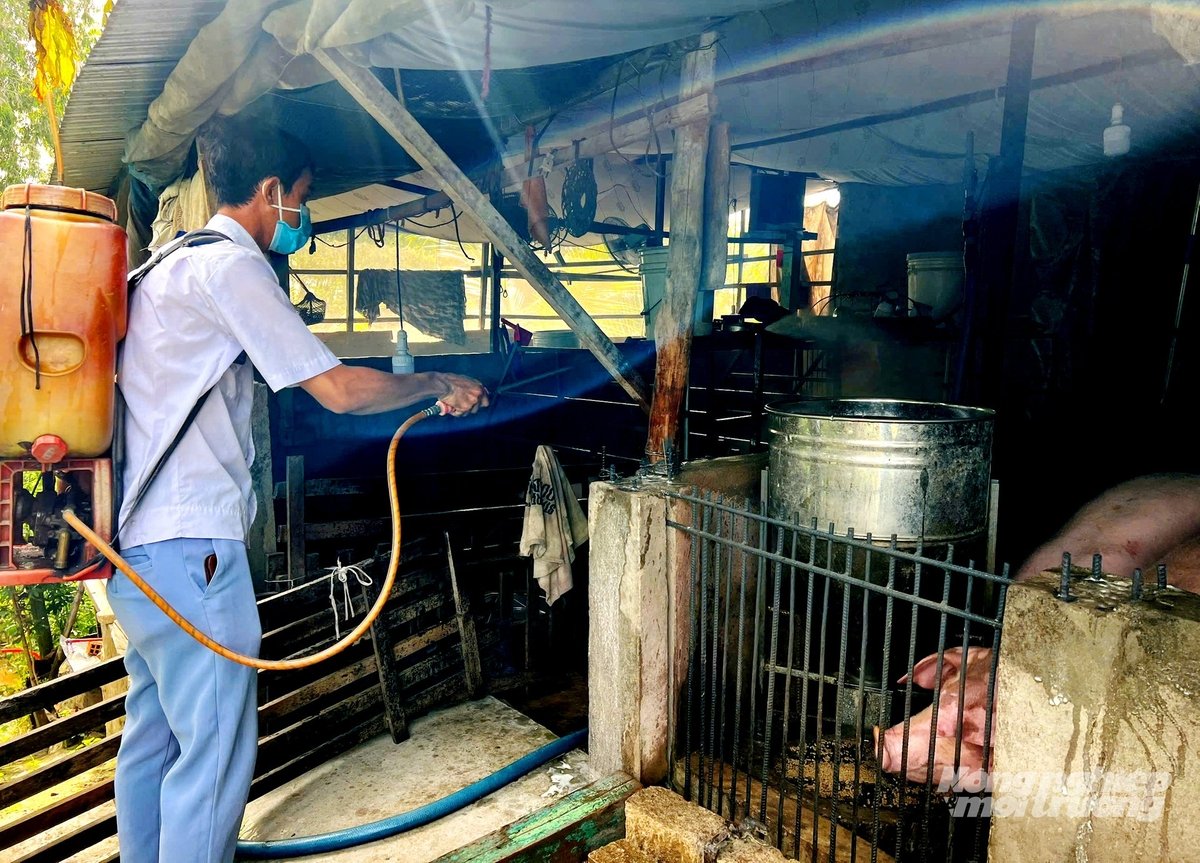December 3, 2025 | 22:18 GMT +7
December 3, 2025 | 22:18 GMT +7
Hotline: 0913.378.918
December 3, 2025 | 22:18 GMT +7
Hotline: 0913.378.918
Playing an important role in supplying food to the market, the pig farming industry in An Giang province, particularly in the Tan Chau area, has remained stable for a long period of time. The entire Tan Chau area currently has 171 pig farming households totaling 2,914 pigs, including 165 small-scale households with 2,535 pigs and 6 small-scale farms with 379 pigs. Most households raise pigs for self-consumption and sale to the domestic market.

Veterinary staff provide information and guide livestock farmers on how to implement biosecurity measures to prevent African swine fever. Photo: Le Hoang Vu.
In recent years, households have paid more attention to cleaning and disinfecting barns. However, the transportation and trading of breeding pigs and pigs for meat between localities still occur frequently, so the risk of disease transmission remains high.
Nguyen Ngoc Khai, Head of the Agricultural Technical Station of the Tan Chau region, said, “Up to this point, the disease situation in the pig herd has been basically stable. However, the risk of an outbreak of African swine fever is always latent and can occur at any time. This disease can spread quickly, has a high mortality rate, and causes great damage if not controlled in time.”
The Agricultural Technical Station of the Tan Chau region has received, studied, and promptly implemented the directives of the Ministry of Agriculture and Environment, An Giang Department of Agriculture and Environment, and the Sub-Department of Livestock Production and Animal Health.
After developing the African swine fever prevention and control plan in detail, the Station coordinates with the People's Committees of communes and wards to strengthen the Steering Committee, establishes rapid response teams and carcass disposal teams, and selects locations to destroy sick pigs when necessary.
During the inspection and monitoring work, the Station has deployed a campaign to clean, disinfect, and sterilize the farming environment throughout the region, distributing 167 liters of disinfectant to 5 communes and wards, including Tan Chau, Long Phu, Tan An, Vinh Xuong, and Chau Phong. It also collects samples for virus monitoring at slaughterhouses, and the results were all negative. As a result, Tan Chau has not recorded any new outbreaks up to the present date.
From Khai’s perspective, the current epidemic prevention work has both advantages and difficulties. Regarding advantages, the government and the veterinary sector have given concise directives, the grassroots veterinary network has been maintained stably and supported arising situations swiftly. Local farmers have also gradually raised their awareness in barn cleaning, disinfection and vaccination.
Despite ample efforts, difficulties remain. Most of the farming households work on a small scale. Their barns do not meet standards, making it difficult to control diseases. Funding for disease prevention is limited, and protective equipment and chemicals are not sufficient. The recent merger of communes and wards has also disrupted livestock management and quarantine coordination.
In reality, some small outbreaks have appeared in small-scale farms in the borderlands and newly merged areas. The main causes are biosecurity violations, pig transportation without quarantine or improper waste treatment.
As soon as the outbreaks are detected, local authorities activate a plan to prevent and control the disease, zoning the affected area, destroying sick pigs, disinfecting barns, controlling transportation, and temporarily suspending unsafe slaughterhouses. Interdisciplinary rapid response teams are established to thoroughly handle the source of the disease, including the Commune People's Committee, the Livestock Production and Animal Health Station, the police, and the military.

Veterinary staff spray disinfectant on livestock barns to ensure environmental hygiene and limit the spread of pathogens. Photo: Le Hoang Vu.
An Giang promotes the "5 no's" principle to raise public awareness: No concealment of disease outbreaks; no transportation of pigs out of the epidemic area; no slaughter of infected pigs; no consumption of sick pigs; no discard of pig carcasses into the environment.
The provincial Department of Agriculture and Environment has implemented many synchronous solutions, such as strengthening coordination between specialized agencies and the People's Committees of communes and wards in the process of developing disease prevention plans, improving monitoring and early warning capacity. Communication work is carried out regularly through the loudspeaker system and residential meetings. Farmers are encouraged to declare cases of sick pigs honestly and handle them according to regulations.
Thai Hoang Nam, Deputy Head of An Giang Sub-Department of Livestock Production and Animal Health, said, "Thanks to the drastic participation of functional sectors and cooperation from the people, African swine fever prevention and control work in An Giang is being implemented synchronously, contributing to protecting the total herd, stabilizing food supply and ensuring sustainable livestock development."
Translated by Samuel Pham
/2025/12/01/0509-2-175427_206.jpg)
(VAN) Emission-reducing coffee areas in Lam Dong have entered the new crop with stable yields, improved quality, and a remarkably enhanced cultivation environment.

(VAN) The Institute of Agricultural Sciences for Southern Vietnam (IAS) marked its 100th anniversary in Ho Chi Minh City, celebrating a century of growth as a leading institute contributing significantly to Viet Nam’s agricultural development.

(VAN) An increasing number of livestock farms are using biogas generators to create a source of renewable electricity, helping to save costs and mitigate environmental pollution.

(VAN) Small changes in rice cultivation, from irrigation methods and straw collection to input management, are paving a new way for Vietnam's agriculture in the journey toward emission reduction.

(VAN) With the project of converting biogas into renewable electricity, Australia is both helping pig farms reduce their energy costs by up to 25% and contributing to environmental protection.
![Hue aims for Net Zero: [1] Initial steps from green transportation](https://t.ex-cdn.com/nongnghiepmoitruong.vn/608w/files/huytd/2025/11/28/0853-anh-6-giao-thong-xanh-hue-094717_940-153724.jpg)
(VAN) For sustainable development, Hue City is implementing many solutions to promote green transportation, which is an important initial step on the journey to building a Net Zero Hue.

(VAN) Nghe An Province, one of the localities with the largest forest area in Vietnam, is set to gain significant benefits from the implementation of forest carbon credit payments.